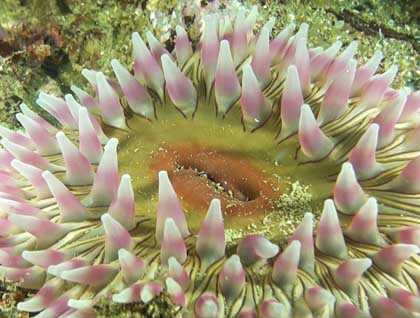The early morning fog surrounded us and the National Geographic Sea Bird navigated cautiously, using the foghorn every few minutes; it seemed as if we were alone in the world and the beauty of the scene was remarkable. We soon arrived to George Island, where we spent the morning. Located off the northern shore of the large Chichagof Island, George is a very interesting place to explore. And we did so by hiking, tide-pooling, kayaking and in my case, scuba diving. Amy Sobesky and I went diving off George Island to take underwater video of the inhabitants of the kelp forest and rocky reefs, like leather and sunflower sea stars, painted and stubby rose anemones, kelp greenlings, and Pacific cod. Meanwhile, kayakers paddled along the shore looking at the rugged landscape and the occasional sea lion and harbor seal, whereas hikers reached the site of a former WWII post that was used to protect the northern entrance to the Inside Passage.
After leaving George Island we headed towards our anchorage at the Hobbit Hole in the Inian Islands. The Inians are very close to George and the small archipelago creates a bottleneck for the waters flowing in and out of Icy Strait; as a result, strong tidal currents stir the bottom, forming whirlpools and standing waves that bring nutrients and fish schools, making this an extremely productive area, well known among commercial and sport fishermen. We boarded our expedition landing craft to explore the Inians and were rewarded with numerous marvelous sightings of Steller’s sea lions, bald eagles, harbor porpoises, sea otters, and humpback whales. The sea otters in particular were very cooperative today and seemed to be as curious about us as we were about them. Sea otters were responsible for the Russian occupation of Alaska during the second half of the XVIII century, when as many as possible were hunted and their pelts sold to the Chinese. As a result, the sea otter population here diminished greatly (and went extinct in many other areas to the south, as far as Baja California in Mexico); today their numbers are increasing and sea otters are once again a common sight in Southeast Alaska.
During the evening we headed towards the entrance of Glacier Bay National Park, our next destination for tomorrow, and the calm seas and clear skies joined forces to make a wonderful postcard and a fitting end of a beautiful day.







